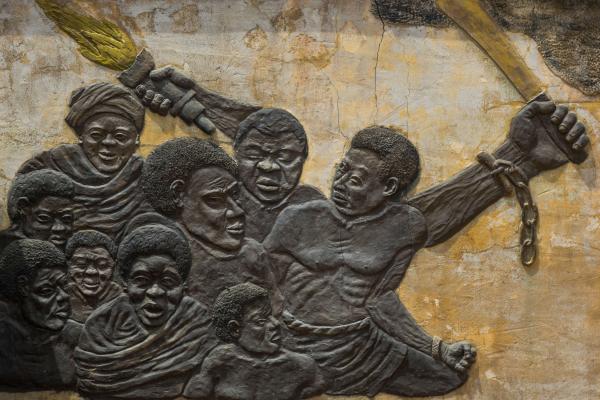Donald Trump’s tweet, comparing the legal and constitutional process of impeachment with the racial terror of lynching, is one among the cascade of immoral, ahistorical, white supremacist comments made by the president.
This one struck a nerve.
Around 4,700 extra-judicial killings, often in concert with law enforcement and magistrates, took place in the United States from 1882 to 1968. The majority of these lynchings involved white people killing black people, although white Americans also used lynching as a tool of racial violence to control Latinx and Chinese communities.
This week, some politicians condemned the president’s lynching comment. Scholars spoke to the ignorance of Donald Trump. Pollsters pointed out the increasingly erratic and incendiary language as the President’s crimes come clearer into view. But what I found most fascinating was the number of times lynching has been utilized by politicians to describe the hot water in which they find themselves.
Clarence Thomas once called himself a victim of a “high-tech lynching” when Anita Hill accused him of sexual harassment. In 1998, Joe Biden said that Clinton’s impeachment could be seen as a “bipartisan lynching.” That same year, Rep. Jerrold Nadler (D-N.Y.) described the GOP as “running a lynch mob.”
When politicians use this language, they devalue black, Latinx, and Asian people who lived not just moments of trauma but underwent an era of terror. Lynching was one among many tools used to undo post-Civil War Reconstruction gains for formerly enslaved peoples and immigrants.
“Slavery didn’t end in 1865,” writes Bryan Stevenson, the director of the Equal Justice Initiative, “it just evolved.” During Jim Crow, the way to maintain white supremacy was through a calculated, politically-driven campaign of racial terror we call lynching.
Over the past year and a half, I’ve been part of growing a coalition for truth-telling around the racial terror of lynching in my home state of North Carolina. Within the parameters set by our partner organization, the Equal Justice Initiative, there was one Jim Crow-era lynching in my county.
In the fall of 1918, Ruby Rogers, a farm wife isolated to unincorporated Rolesville, N.C., claimed she’d been attacked. A black man had broken into her home, she told the police, and used a razor to cut her. She was knocked unconscious and woke on the floor, her baby beside her.
During the investigation three black men were brought to Mrs. Rogers and released before George Taylor was picked up in Wilson, N.C. and transported by train back to the site of the alleged crime. At first, Mrs. Rogers was unable to identify Mr. Taylor as the perpetrator but had a change of mind when she saw him stand on her lawn.
Mr. Taylor was being driven back to the jail when the car was intercepted by four men wearing masks. They brought Mr. Taylor to a ravine and waited as a crowd of 300 white citizens gathered. The next morning, Mr. Taylor was found hanging from his feet from a tree, shot over 100 times. His body was bruised and cut. Some of the mob took bullets from Mr. Taylor’s body as souvenirs.
It is impossible to use the language of lynching without calling to mind horrors like those visited upon George Taylor. But using this language does provide white supremacists, like Donald Trump, an opportunity to shift people’s attention away from the historic trauma of lynching. The more often the word is used with flippant disregard, the further we are skewed from the truth of our collective past.
This form of reshaping history through language was also a tool for the ascendancy of white supremacists campaigns in the South. Throughout the 1890s, North Carolina politicians would recast the defeat of the Confederacy, no longer centering it on slavery but on state’s rights.
Slavery was "the occasion, not the cause of the war," said Col. Alfred Moore Waddell, one of the architects of the Southern Democrat’s strategy to retake control of North Carolina.
This strategy was to use white, Southern pride to create a bloc. Race would be the wedge. Using a “write, speak, ride” strategy (write about white pride, speak about white pride in public, enact racial violence with willing men), Southern Democrats reshaped the Confederate loss from a source of shame to a moment of pride.
The language of lynching matters. Words shape our history and how we understand our past determines who we are in the present. And it is through our understanding the political capital created by lynching that we can draw the line to the racial terror of prisons, capital punishment, and policing today.
The Equal Justice Initiative encourages communities to memorialize lynching victims as a work of narrating the past in a way that reforms our current community. In their report on memorialization, they write: “national commemoration of the atrocities inflicted on African Americans during decades of racial terrorism is an important step towards establishing trust between the survivors of racial terrorism and the governments and legal systems that failed to protect them. Meaningful public accountability is critical to bring the cycle of racial violence to a close.”
Hundreds of counties in the United States hold the untold stories of lynching victims. From California to Montana to Illinois to Florida, there is work to do. One way to deconstruct the violence of Donald Trump’s racism is to use this as an occasion to deepen our commitment to truth-telling about racial violence in our local communities, both past and present.
Got something to say about what you're reading? We value your feedback!







